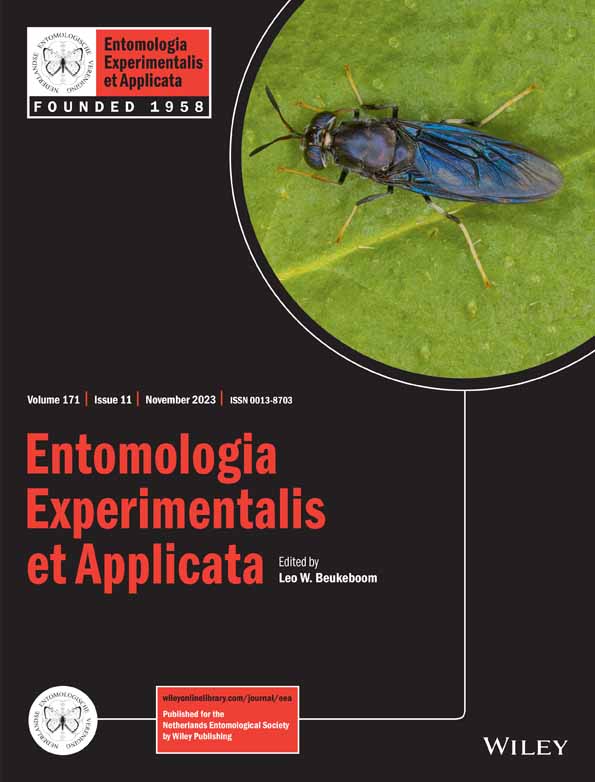Ver ítem
- xmlui.general.dspace_homeCentros e Institutos de InvestigaciónCICVyA. Centro de Investigación en Ciencias Veterinarias y AgronómicasInstituto de Microbiología y Zoología AgrícolaArtículos científicosxmlui.ArtifactBrowser.ItemViewer.trail
- Inicio
- Centros e Institutos de Investigación
- CICVyA. Centro de Investigación en Ciencias Veterinarias y Agronómicas
- Instituto de Microbiología y Zoología Agrícola
- Artículos científicos
- Ver ítem
Genetic diversity of the polyphagous pest Rachiplusia nu across crops and locations in the Argentine Pampas
Resumen
Rachiplusia nu (Guenée) (Lepidoptera: Noctuidae, Plusiinae) is a defoliator of soybean (Glycine max L., Fabaceae), sunflower (Helianthus annuus L., Asteraceae), alfalfa (Medicago sativa L., Fabaceae), and horticultural crops in temperate southern South America; however, there is little genetic information available about this pest insect. Recently, concerns about this insect have increased because of its suspected resistance to Bt soybean and its spread
[ver mas...]
Rachiplusia nu (Guenée) (Lepidoptera: Noctuidae, Plusiinae) is a defoliator of soybean (Glycine max L., Fabaceae), sunflower (Helianthus annuus L., Asteraceae), alfalfa (Medicago sativa L., Fabaceae), and horticultural crops in temperate southern South America; however, there is little genetic information available about this pest insect. Recently, concerns about this insect have increased because of its suspected resistance to Bt soybean and its spread to tropical regions. To better understand pest dynamics, and therefore implement suitable management strategies, a thorough knowledge of the genetic variability and spatial structuring of populations is required. In this paper, R. nu larvae were sampled from various crops and locations in central Argentina (where the pest is endemic) to assess diversity and population structure through mtDNA sequence analysis. In addition to the analysis of the standard cytochrome c oxidase subunit I (COI) ‘barcode’ fragment, a new set of primers was developed to explore genetic variation in the cytochrome b (Cytb) gene. COI and Cytb concatenated sequences revealed an overall high haplotype diversity (mean ± SD = 0.798 ± 0.037) and low nucleotide diversity (0.00137 ± 0.00013). The haplotype network showed a total of 19 haplotypes, separated by at most five mutational steps. A main central haplotype and four additional frequent haplotypes (accounting for 80% of the specimens examined) were distributed across populations with no obvious pattern related to host plant or geographic origin. Analysis of molecular variance further supported a weak population structure, where genetic variation within populations was the main source of total variation (ca. 96%). Pairwise comparisons showed only minor genetic differentiation among some of the populations studied. Implications of these findings in the context of R. nu control are discussed.
[Cerrar]

Autor
Decker Franco, Cecilia;
San Blas, Germán;
Balbi, Emilia Ines;
Fichetti, Patricia;
Puebla, Andrea Fabiana;
Toledo, Andrea Vanesa;
Arneodo Larochette, Joel Demian;
Fuente
Entomologia Experimentalis et Applicata 171 (11) : 887-895 (Septiembre 2023)
Fecha
2023-09-19
Editorial
Wiley
ISSN
0013-8703
1570-7458
1570-7458
Documentos Relacionados
Formato
pdf
Tipo de documento
artículo
Proyectos
(ver más)
INTA/2019-PD-E4-I079-001, Genética, genómica y ecología de insectos de importancia agronómica como insumo para el desarrollo de estrategias sustentables de control plagas
INTA/2023-PD-L01-I074, Bases ecológicas y epidemiológicas para el diseño de estrategias de manejo de plagas agrícolas y forestales
Palabras Claves
Derechos de acceso
Restringido
 Excepto donde se diga explicitamente, este item se publica bajo la siguiente descripción: Creative Commons Attribution-NonCommercial-ShareAlike 2.5 Unported (CC BY-NC-SA 2.5)
Excepto donde se diga explicitamente, este item se publica bajo la siguiente descripción: Creative Commons Attribution-NonCommercial-ShareAlike 2.5 Unported (CC BY-NC-SA 2.5)


